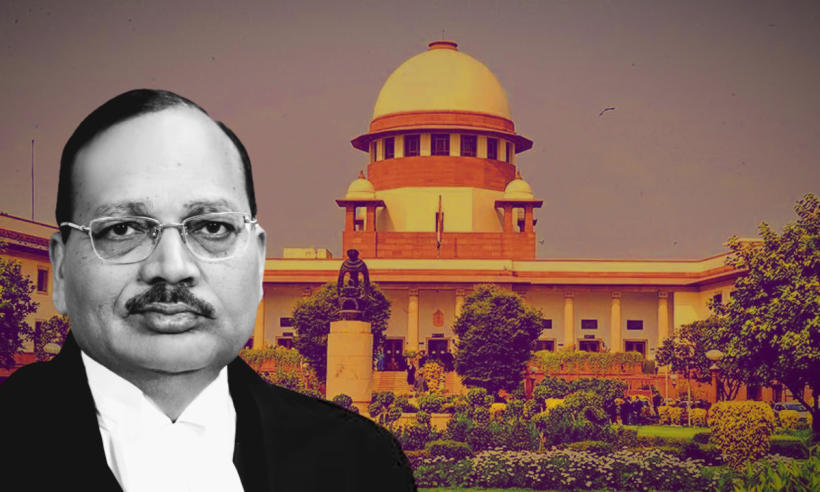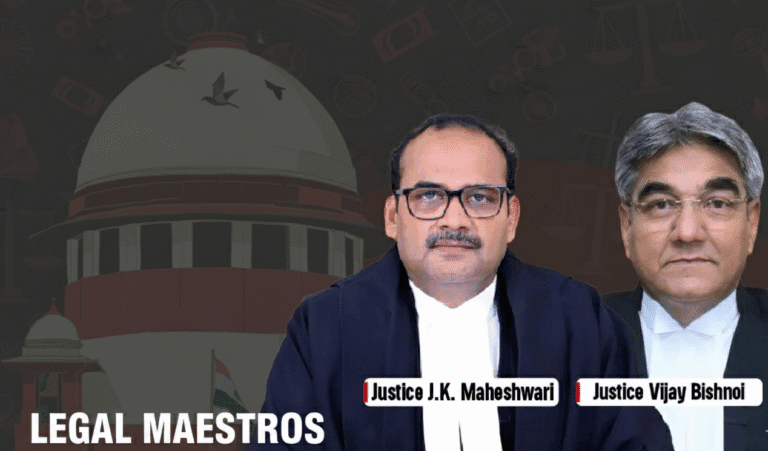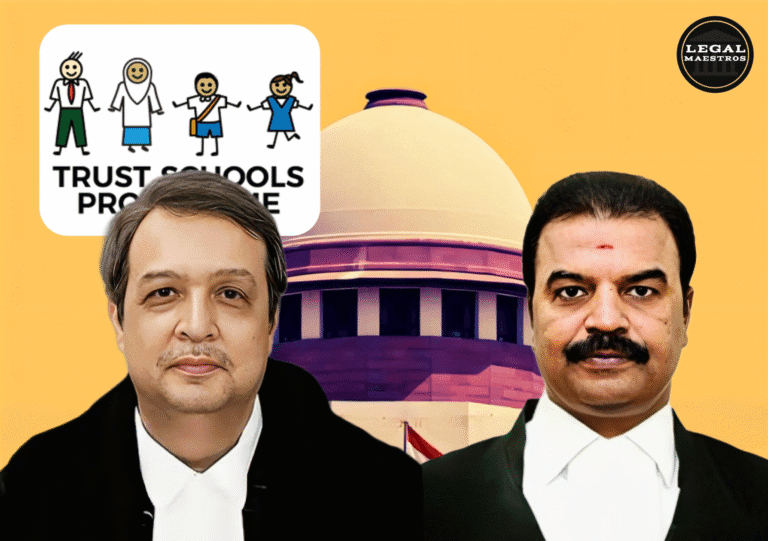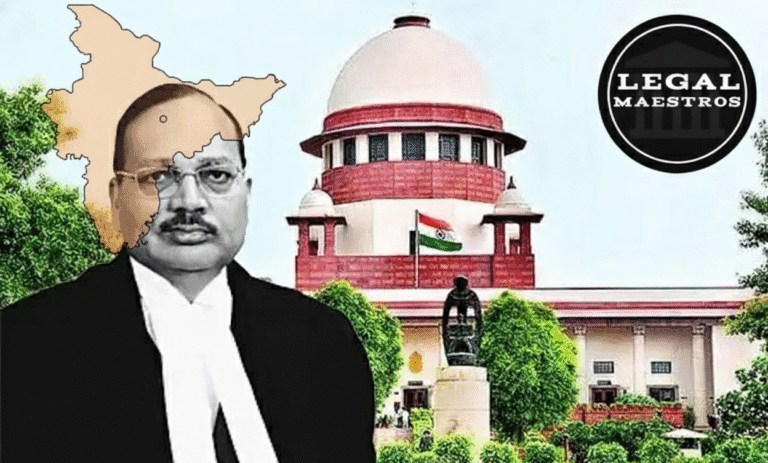
Supreme Court, Led by Justice Surya Kant, Holds DDA Accountable in Delhi Ridge Contempt Case and Charts Course for Environmental Restoration
Introduction
In the contempt proceedings that were brought about by the MC Mehta case, the Supreme Court of India issued a verdict that serves as an indication of the unshakable devotion of the court to both executing its own rules and safeguarding the environment.
This ruling was handed down earlier this year. On May 28, 2025, Justices Surya Kant and Nongmeikapam Kotiswar Singh handed down their decision about the willful removal of trees from the ecologically sensitive Delhi Ridge, despite the fact that the court had explicitly instructed them to do so.
In response to the problem, the decision was made. Concerns about the use of contempt powers, the interplay between environmental law and administrative action, and the greater public interest in sustainable development are brought to light as a result of the ruling. The present controversy that has been brought up by the verdict is not the only thing that these questions cover.
For any queries or to publish an article or post or advertisement on our platform, do call at +91 6377460764 or email us at contact@legalmaestros.com.
Background of the Controversy
This ground-breaking writ petition, which was filed by MC Mehta in 1985 and attempted to preserve rivers and forests, was finally resolved in 1996 with directives to prevent encroachment on the Delhi Ridge.
Beginning with the petition itself, this discussion has been going on for quite some time. Following the implementation of the Delhi Master Plan and accompanying laws, the Ridge was given the status of a Reserved Forest.
There was a bar on the destruction of any structure or tree without first getting authority, and its boundaries were also clearly designated. The Delhi Development Authority (DDA), on the other hand, submitted an application for authorization to construct approach roads to a number of institutions, including the Central Armed Police Forces Institute of Medical Sciences (CAPFIMS) and the South Asian Association for Regional Cooperation (SAARC) University.
For any queries or to publish an article or post or advertisement on our platform, do call at +91 6377460764 or email us at contact@legalmaestros.com.
In February of 2024, the Delhi Development Authority (DDA) began cutting down more than a thousand trees, while at the same time seeking a variety of licenses. This was done without first obtaining permission from the Supreme Court or statutory permits under the Forest Conservation Act of 1980 and the Delhi Preservation of Trees Act of 1994.
In the petition that Bindu Kapurea presented, there was a claim that she had disobeyed the order that had been issued on May 9, 1996. This claim was contained in the petition.
For More Updates & Regular Notes Join Our Whats App Group (https://chat.whatsapp.com/DkucckgAEJbCtXwXr2yIt0) and Telegram Group ( https://t.me/legalmaestroeducators )
For any queries or to publish an article or post or advertisement on our platform, do call at +91 6377460764 or email us at contact@legalmaestros.com.
Legal Provisions Invoked
Section 12 of the Contempt of Courts Act, 1971, which controls civil contempt, and Article 129 of the Constitution, which gives the Supreme Court the ability to punish for contempt, were both essential in establishing the Court’s authority to hear and rule on these proceedings.
Both of these provisions were enacted in 1971. Furthermore, Rule 3(c) of the Rules to Regulate Proceedings for Contempt of the Supreme Court, which was published in 1975, was applicable in this situation.
In relation to the Forest Conservation Act of 1980, which mandates that the central government must give its approval before forest land can be diverted; the Delhi Preservation of Trees Act of 1994, which governs the felling of trees in the National Capital Territory; and the authority of the Ridge Management Board, which was established in 1995, as well as the Central Empowered Committee, which was established in Godavarman, 2002, the petition in question raised questions.
For any queries or to publish an article or post or advertisement on our platform, do call at +91 6377460764 or email us at contact@legalmaestros.com.
Fundamental Issues Considered by the Court
Second, the deliberate concealment of ongoing tree felling during the hearing that took place on March 4, 2024; and third, the failure to get particular consent from the Supreme Court prior to the installation of trees inside the Ridge.
Upon making its decision, the Court discovered two distinct instances of contempt of court. Due to this concealment, which struck at the very core of the judicial structure, the Court’s ability to evaluate compliance was impaired.
This was a significant limitation. Furthermore, the review assessed whether the actions made by the DDA were the result of a genuine administrative error or a willful disrespect for the law. This was taken into consideration. In order to differentiate between intentional disobedience, which is a threat to the rule of law, and technical non-compliance, which may be deserving of a liberal opportunity to cleanse, a differentiation came about.
For any queries or to publish an article or post or advertisement on our platform, do call at +91 6377460764 or email us at contact@legalmaestros.com.
In the context of striking a balance between competing public interests, the Court acknowledged the vital role that CAPFIMS plays in providing emergency medical care to paramilitary troops and their families.
A compelling public purpose would be effectively fulfilled by roads with a more wider plan, as was recognized by the document. On the other hand, it stressed that only in order to justify breaking constitutional and legislative restrictions that are designed to preserve natural balance, it would not be sufficient to meet such criteria.
Court’s Findings on Contempt
The conduct of the DDA officials were deemed to be criminal contempt by the Supreme Court, which made this determination in line with the terms of Section 2(c) of the Contempt of Courts Act.
For any queries or to publish an article or post or advertisement on our platform, do call at +91 6377460764 or email us at contact@legalmaestros.com.
It was discovered that intentional violations of the order that was issued in 1996 occurred when more than a thousand trees were chopped down without authority. This was a breach of the order.
The withholding of important information during proceedings is yet another example of an intentional attempt to hinder the administration of justice. It was ruled by the court that there was no legitimate cause for the nondisclosure, despite the fact that the DDA argued that they had a fundamental misunderstanding of the approvals.
Despite this, the Court made the decision to proceed with calibrated remedy rather than the most severe penalty because it was mindful of the institution’s goal to serve the public good and since there was no evidence that the institution had a malevolent motive.
For any queries or to publish an article or post or advertisement on our platform, do call at +91 6377460764 or email us at contact@legalmaestros.com.
Remedial and Corrective Directions
In order to bring about the removal of contempt and the restoration of environmental integrity, the Court gave a full set of orders from which to choose. It re-empowered the Committee of prominent environmentalists, which included Shri Ishwar Singh, Shri Sunil Limaye, and Shri Pradip Krishen, to monitor compensatory afforestation work across 185 acres that were identified by the DDA during the course of the project.
Within a period of three months, the Committee is obligated to conduct an assessment of the area’s appropriateness, choose native plants, and initiate planting plans in line with the monsoon.
The Department of Forestry will be responsible for carrying out the implementation of the plan and monitoring the survival rates. The Department will get all of its financing from the Department of Development and Administration.
For any queries or to publish an article or post or advertisement on our platform, do call at +91 6377460764 or email us at contact@legalmaestros.com.
It is necessary to give compliance reports every two years, and these reports must be accompanied by photographic and video evidence to demonstrate their authenticity.
Along with the building of the approach roads, which included the planting of extensive green cover along the roadside, the Court also ordered the construction of the approach roads as part of the ecological safeguards.
In accordance with the principles of natural justice, it provided the government the ability to levy a one-time tax on direct receivers. This was done in awareness of the potential for affluent individuals to derive private benefit from taxes.
For any queries or to publish an article or post or advertisement on our platform, do call at +91 6377460764 or email us at contact@legalmaestros.com.
Due to the fact that the petition against the former Vice-Chairman was closed since he had left his position, the DDA officials who did not comply with the order were issued the order to pay an environmental fee of ₹25,000 each, or else they would be subject to censure from the department.
Impact on Environmental Jurisprudence
A number of basic concepts that form the basis of environmental law in Japan have been reaffirmed as a result of the ruling in this proceeding. It begins by reiterating that public bodies are obligated to get judicial approval before to infringing onto protected forest areas.
This is particularly important in circumstances when there are competing interests in terms of development. Secondly, it highlights the fact that contempt powers may be used to assure compliance with environmental orders, which contributes to the preservation of the Supreme Court’s autonomy under the Constitution.
For any queries or to publish an article or post or advertisement on our platform, do call at +91 6377460764 or email us at contact@legalmaestros.com.
By including compensatory afforestation and beneficiary charges into the system, the Supreme Court, in the end, made the notion of “polluter pays” more applicable in a public milieu.
Ultimately, the decision emphasizes the responsibility of the court as a parens patriae, which is to safeguard the interests of vulnerable communities for the sake of preserving the natural inheritance for the generations who will come after us. The relatives of those who are members of the paramilitary in this instance.
Conclusion
The Delhi Ridge contempt case may provide insight into a complex network of legal concepts as well as important truths about life. It demonstrates the Supreme Court’s unwavering desire to carry out its decisions, especially when they are in opposition to powerful government bodies, despite the fact that it retains a realistic understanding of the imperatives of growth.
For any queries or to publish an article or post or advertisement on our platform, do call at +91 6377460764 or email us at contact@legalmaestros.com.
The verdict created a thorough remedial system, which is a strong indicator that environmental conservation in India is not just a desired aim but also a legally binding one. This is a significant signal that the nation is committed to protecting the environment. Within the confines of constitutional and legislative safeguards, the decision will serve as a compass, prompting the authorities to remember that sustainable development must take place.
As the requirements that are linked with urbanization continue to become more stringent, this decision will act as a compass. Because of the ruling made by the Court to protect the lungs of Delhi, the relationship between the Rule of Law and ecological stewardship has been reinforced.




![Research Assistantship @ Sahibnoor Singh Sindhu, [Remote; Stipend of Rs. 7.5k; Dec 2025 & Jan 2026]: Apply by Nov 14, 2025!](https://legalmaestros.com/wp-content/uploads/2025/11/Gemini_Generated_Image_s0k4u6s0k4u6s0k4-768x707.png)
![Karanjawala & Co Hiring Freshers for Legal Counsel [Immediate Joining; Full Time Position in Delhi]: Apply Now!](https://legalmaestros.com/wp-content/uploads/2025/11/Gemini_Generated_Image_52f8mg52f8mg52f8-768x711.png)
![Part-Time Legal Associate / Legal Intern @ Juris at Work [Remote]: Apply Now!](https://legalmaestros.com/wp-content/uploads/2025/11/ChatGPT-Image-Nov-12-2025-08_08_41-PM-768x768.png)
![JOB POST: Legal Content Manager at Lawctopus [3-7 Years PQE; Salary Upto Rs. 70k; Remote]: Rolling Applications!](https://legalmaestros.com/wp-content/uploads/2025/11/ChatGPT-Image-Nov-12-2025-08_01_56-PM-768x768.png)